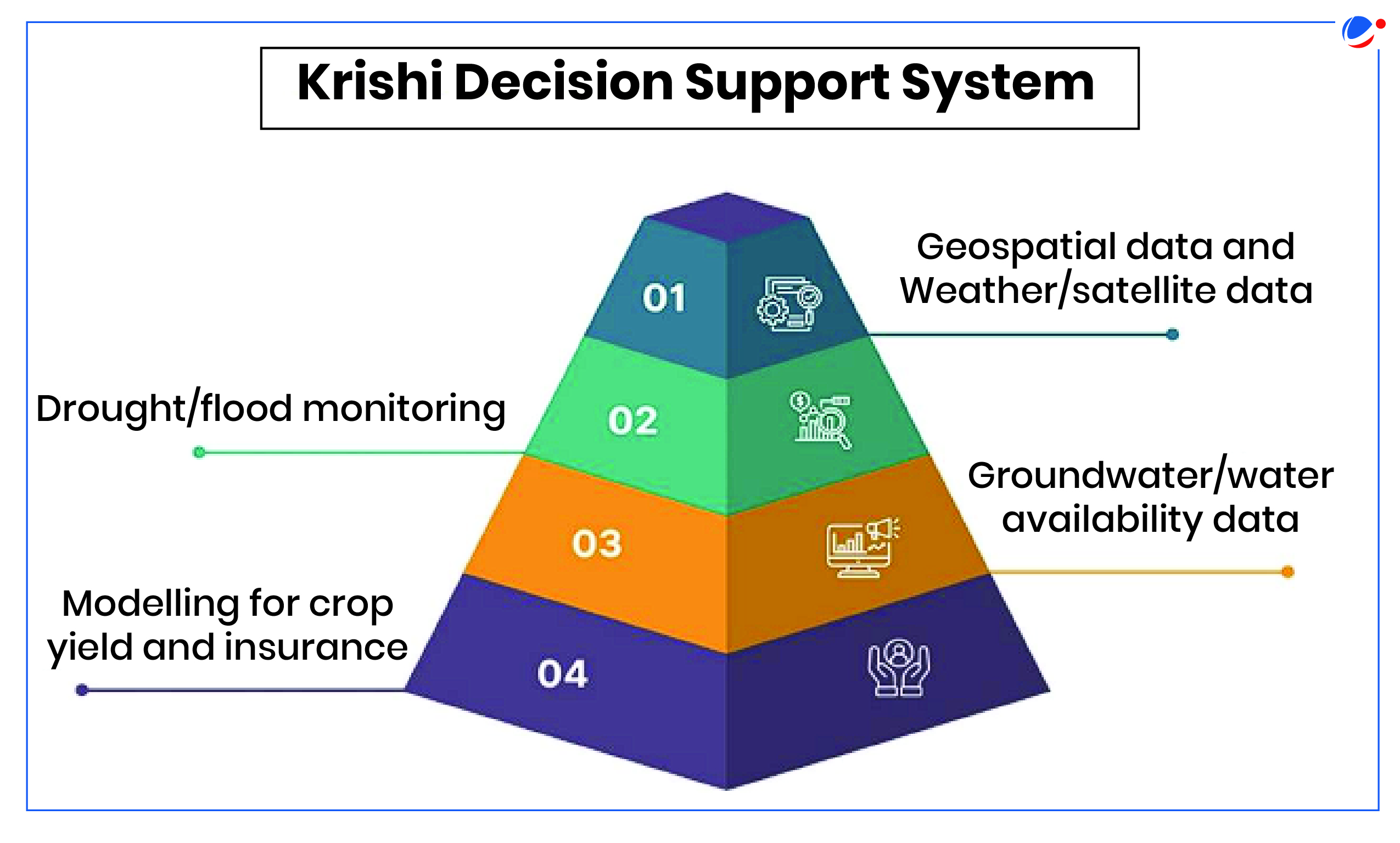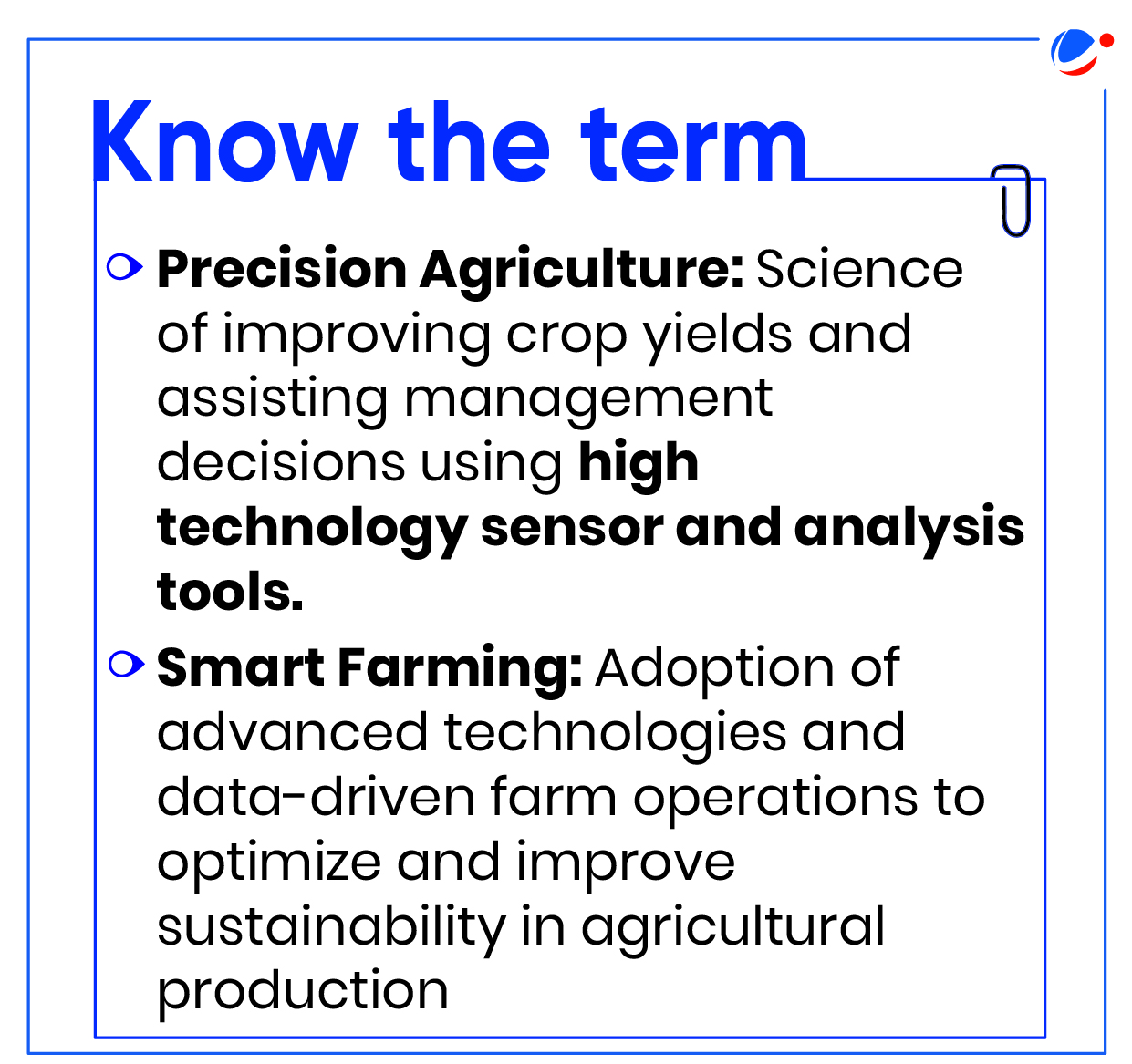Why in the news?
Recently, the Union Cabinet approved the Digital Agriculture Mission with a total outlay of ₹2,817 Crore.
About Digital Agriculture Mission (DAM)
- It is an umbrella scheme based on the structure of Digital Public Infrastructure (DPI) aimed at using technology to improve farmers' lives.
- It is in line with the Union Budgets' 2024-25 and 2023-24 announcement of implementing DPI in agriculture.

Key features of the Mission
- It is built on 2 foundational pillars:
- Agri Stack (Kisan ki Pehchaan): A farmer-centric DPI to streamline services and scheme delivery to farmers with 3 key components:
- Farmers' Registry: Issuance of 'Farmer IDs', created and maintained by the State Governments/ Union Territories, which will act as a trusted digital identity for farmers, similar to Aadhaar.
- Geo-referenced village maps: Linking of the Farmer IDs to farmer-related data. E.g. Land records, demographic and family details etc.
- Crop Sown Registry: Maintaining a record of crops sown in each season by farmers through mobile-based ground survey, that is, Digital Crop Survey.
- Krishi Decision Support System (DSS): To integrate remote sensing data on crops, soil, weather, and water resources into a comprehensive geospatial system.
- Agri Stack (Kisan ki Pehchaan): A farmer-centric DPI to streamline services and scheme delivery to farmers with 3 key components:
- Soil Profile Mapping: Detailed soil profile maps on a 1:10,000 scale for approximately 142 million hectares of agricultural land.
- Digital General Crop Estimation Survey (DGCES) will provide yield estimates based on scientifically designed crop-cutting experiments.
- Key Targets:
- Create digital identities for 11 crore farmers over three years (6 crores in FY 2024-25, 3 crores in FY 2025-26, and 2 crores in FY 2026-27).
- Digital Crop Survey to be launched nationwide in 2 years, covering 400 districts in FY 2024-25 and all districts in FY 2025-26.

About Digital Agriculture
- It can be defined as the use of modern technology by farmers to improve farm activity management by making it scientific and data-driven.
- It is the consistent application of methods of 'Precision agriculture' and 'Smart farming', internal and external networking of the farm and use of web-based data platforms together with Big Data analyses.
- Examples of digital technologies for Agriculture Sector
- Use of drones to fight locusts in India (2019): Used for anti-locust spraying to reduce crop losses.
- Grain Bank Model of 'Ergos': Providing doorstep access to end-to-end post-harvest supply chain solutions to small and marginal farmers.
- Yuktix GreenSense: An off-grid remote monitoring and analytics solution for effective tool for monitoring and DPI (Disease, pest, and irrigation) management.
Significance of Digital Agriculture Mission
- Aid farmers to take informed decisions.
- E.g. DGCES-based data will help crop diversification and evaluation of irrigation needs which will aid in making agriculture sustainable.
- Accurate data on crop area and yield will enhance efficiency and transparency in agri-production, and implementation of government schemes like crop insurance, loan disbursement etc.
- Preventing and mitigating losses and increase in farmers' incomes.
- E.g. Crop map generation and monitoring for better disaster response and insurance claims.
- Mission is expected to create direct and indirect employment in agriculture, by providing opportunities to about 2.5 lakh trained local youth and Krishi Sakhis.
- Improved service delivery for farmers, including –
- Access to government schemes, crop loans, and real-time advisories with the use of modern technology like data analytics, AI, and remote sensing.
- Digital authentication for accessing services and benefits, reducing paperwork and the need for physical visits.
- Optimized value chains and tailored advisory services for crop planning, health, pest management, and irrigation.
Challenges for effective implementation
- Fragmentation of agricultural land: The average landholding in India is only 1.08 ha, making application of present technology difficult as it is conducive for large farms.
- High initial costs: Digital agriculture requires significant computing, storage and processing power which makes it less scalable due to high costs.
- Lack of sufficient research: The impact technology can have on Indian farming and clarity on profitability is lacking.
- Inadequate infrastructure: Digital infrastructure development is lower in rural areas which can be a hindrance to digitization of agriculture. E.g. lower internet penetration
- Lack of digital literacy: It hinders adoption of digital technologies as farmers have lower trust in newer systems. It also hinders effective maintenance and grievance redressal related to modern equipment.
- Language barriers: Unavailability of varied local languages for technology interface creates barriers in access.
Initiatives for promoting Digital Agriculture
|
Conclusion
To reap the benefits of digital agriculture, focus on factors like affordability, ease of access and operations, easy maintenance of systems, timely grievance redressal, robust R&D and appropriate policy support is paramount. The Digital Agriculture Mission is a step in the right direction to achieve this goal and improve farmers' lives.
Related NewsUnion Minister of State for Agriculture launched Krishi-Decision Support System (Krishi-DSS) a geo-spatial platform to provide real-time information on crop conditions, weather patterns, water resources, and soil health.
Application of Space Technology in Agriculture Sector
Other Initiatives undertaken for use of Space Technology in Agriculture Sector
|






